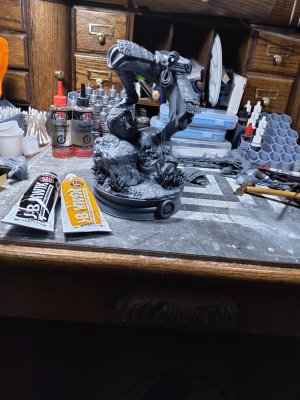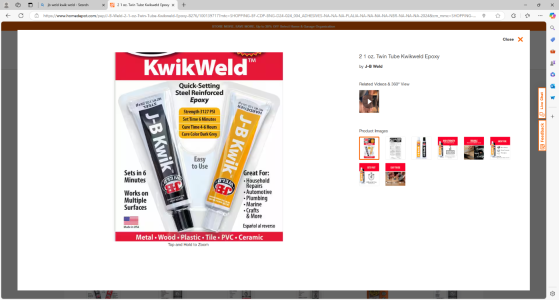-

Win a Free Custom Engraved Brass Coin!!!
As a way to introduce our brass coins to the community, we will raffle off a free coin during the month of August. Follow link ABOVE for instructions for entering.
You are using an out of date browser. It may not display this or other websites correctly.
You should upgrade or use an alternative browser.
You should upgrade or use an alternative browser.
which JB Weld?Greetings
Any tips on the best method for gluing brass to wood? CA doesn’t hold and I have not had success with epoxy (JB Weld).
Thanks
Dan
Hhmm. CA and epoxy are the two most likely to do the job. The glue joints probably failed on the brass side. it might help to clean the surface of the brass with fine sand paper or steel wool before gluing. Also send along a picture of what you're trying to fasten and somebody might come up wit an alternate approach. Fair winds!
I had always a good success with two parts epoxy. If that doesn’t work you might have bad batch of epoxy. Are you sticking to epoxy mixing instructions?
Agree.it might help to clean the surface of the brass with fine sand paper or steel wool before gluing.
I've always drilled a 1/64 or 1/32 hole in the fitting, CA the appropriate brass rod in the hole roughed up the fitting surface and attach to the ship with either CA or Epoxy. Nothing has ever let go.
any epoxy will do the job... both parts will have to be properly cleaned of oxidation or oil.
btw if you are gluing to a finished surface... just scratch it up a bit so the glue has something to grab.
I have yet to find anything original JB Weld could not join permanently, but I have not tried it on jello and water yet.
Last edited:
Ca should do the job as well. Don’t use the thin. Use medium or thick. Make sure the brass is clean and scuff it with some fine sandpaper.
CA is indeed very useful, but it does have a couple of limitations to keep in mind. First is that it will soak into the grain of the wood, which may be less than desirable if you plan to leave the wood unpainted. It also tends to be brittle in my experience, which limits its effectiveness when you have a small surface area in contact. When I am trying to bond anything to wood with CA I like to add a pin of some sort to increase surface area of the join. If it's a flat piece of PE, then I solder a stub on the back, or if it's something with depth I will drill it and CA the pin to that first.Ca should do the job as well. Don’t use the thin. Use medium or thick. Make sure the brass is clean and scuff it with some fine sandpaper.
- Joined
- Jun 29, 2024
- Messages
- 1,280
- Points
- 393

No question it’s a problem. The best way is to use a thick adhesive that sets up hard to if possible provide a mechanical lock. For example, gluing a brass fitting to a deck, should be done with a pin epoxied into a hole. The pin should be clean. I have also used clear nail polish and it’s more robust cousin Duco cement to secure fine brass wire such as hatch eye bolts into tiny drilled holes. It also pays to consider your assembly sequence. If you can get to the backside of the glue joint the wire can be folded over. A heavy blob of Duco cement then encases the folded over wire in plastic.
My current project includes a brass shear strake glued to a wooden hull. The brass to wood joint can have poor peel strength and Andy is right it’s the Epoxy/brass joint that fails. Epoxy needs something to grab ahold of. Industrial coating specifications call this “tooth”. A polished sheet brass surface does not provide this. My plan is to assist the Epoxy by doing two things: First I intend to grit blast the contact surface. I have an Air Eraser for doing this. Second, I intend to punch holes in the sheet. In addition to the hole, punching will leave a little dimple large enough to accept the head of a tiny nail. Once the Epoxy hardens, the countersunk nail head Han be hidden with a dab of Bondo.
I don’t use CA glue.
Roger
My current project includes a brass shear strake glued to a wooden hull. The brass to wood joint can have poor peel strength and Andy is right it’s the Epoxy/brass joint that fails. Epoxy needs something to grab ahold of. Industrial coating specifications call this “tooth”. A polished sheet brass surface does not provide this. My plan is to assist the Epoxy by doing two things: First I intend to grit blast the contact surface. I have an Air Eraser for doing this. Second, I intend to punch holes in the sheet. In addition to the hole, punching will leave a little dimple large enough to accept the head of a tiny nail. Once the Epoxy hardens, the countersunk nail head Han be hidden with a dab of Bondo.
I don’t use CA glue.
Roger
You can use sand paper (60 or 80 grit) on the back of the part you are goint to glue,or use one sharp point and make some scratches on the part,clean the part with acetone and then you can use epoxy ( 5 minutes is perfect ) or CA (gel is better) I have been using this method for years and I am very happy with the results. JB weld is fine, the problem is that cure in 10 to 15 hours and it is to thick.Greetings
Any tips on the best method for gluing brass to wood? CA doesn’t hold and I have not had success with epoxy (JB Weld).
Thanks
Dan
JB Weld Kwik dries in 5-10 minutes.....You can use sand paper (60 or 80 grit) on the back of the part you are goint to glue,or use one sharp point and make some scratches on the part,clean the part with acetone and then you can use epoxy ( 5 minutes is perfect ) or CA (gel is better) I have been using this method for years and I am very happy with the results. JB weld is fine, the problem is that cure in 10 to 15 hours and it is to thick.

- Joined
- Jun 29, 2024
- Messages
- 1,280
- Points
- 393

JB Weld makes a number of products. Some have thickening filler and a few do not. I like JB’s Original Formula. This is a thickened slow curing version. I like the extra working time that it gives me. It seems to now be harder to find.
Thinking more about my brass sheer strake. Skip most of the nails! Use a few nails to position the strake. Punch additional holes into the brass, maybe 3/32 in diameter. When the strake is clamped firmly to the hull, Epoxy should squeeze out through the holes forming a mechanical lock when cured. Excess squeeze out can be easily sanded off without damaging the harder brass. As they, try on scrap first!
Roger
Thinking more about my brass sheer strake. Skip most of the nails! Use a few nails to position the strake. Punch additional holes into the brass, maybe 3/32 in diameter. When the strake is clamped firmly to the hull, Epoxy should squeeze out through the holes forming a mechanical lock when cured. Excess squeeze out can be easily sanded off without damaging the harder brass. As they, try on scrap first!
Roger
In a situation like that, I would solder pins to back of the strake to go through holes in the hull.JB Weld makes a number of products. Some have thickening filler and a few do not. I like JB’s Original Formula. This is a thickened slow curing version. I like the extra working time that it gives me. It seems to now be harder to find.
Thinking more about my brass sheer strake. Skip most of the nails! Use a few nails to position the strake. Punch additional holes into the brass, maybe 3/32 in diameter. When the strake is clamped firmly to the hull, Epoxy should squeeze out through the holes forming a mechanical lock when cured. Excess squeeze out can be easily sanded off without damaging the harder brass. As they, try on scrap first!
Roger








